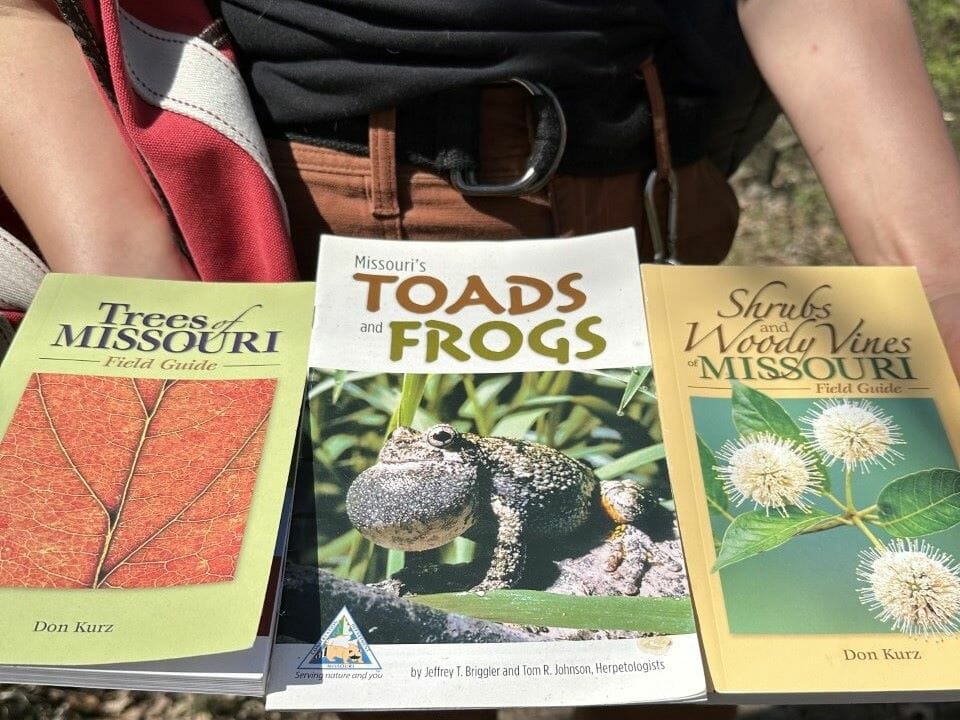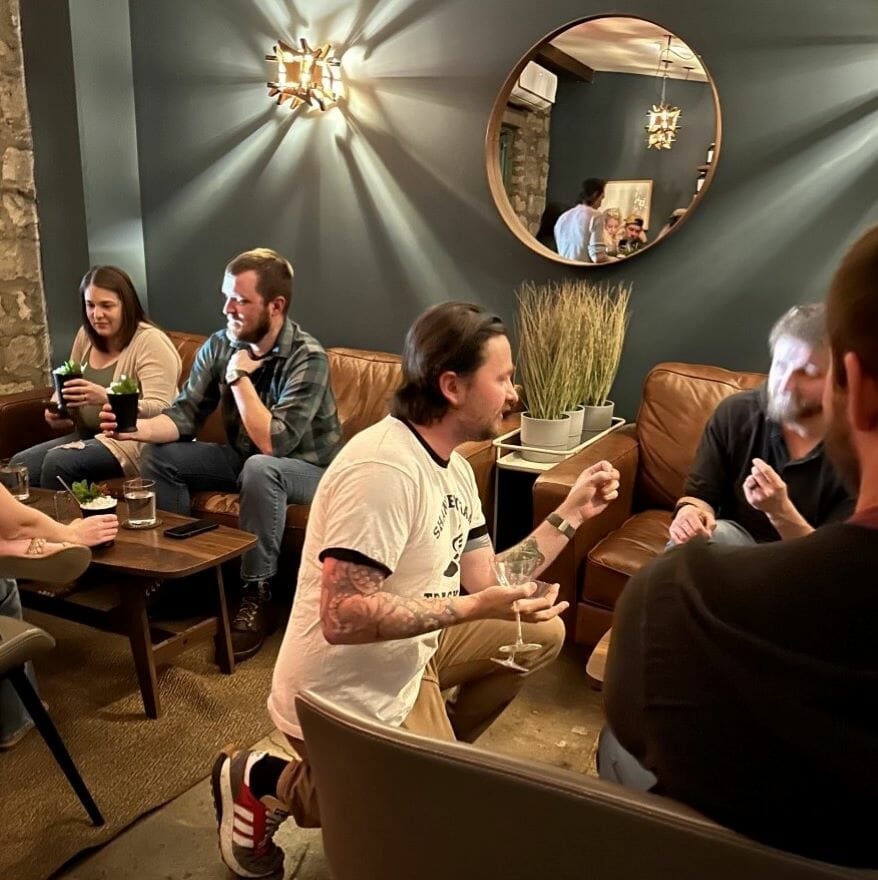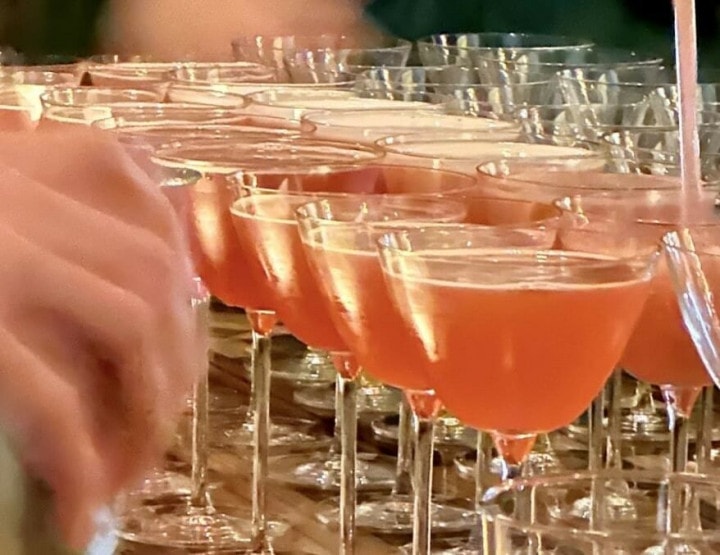- Home | Eats & Drinks |
- Where the Wild Drinks Are: Foraging for Cocktails
Where the Wild Drinks Are: Foraging for Cocktails Savor the Morels of This Story
Published May 5th, 2023 at 6:00 AM
Above image credit: Jay Sanders of Drastic Measures in Shawnee, Rick Mullins of Redbud Kansas City and Raney Yelenich, an amateur mycologist, head into the woods to forage for cocktail ingredients. (Jill Wendholt Silva | Flatland)Jay Sanders pops a handful of tender redbud blossoms into his mouth. The tiny flowers that erupt into puffs of pink, lavender and fuchsia on trees across Kansas City for a few fleeting days each April taste like snow peas.
Sanders is bartender/co-owner of Drastic Measures, a Shawnee bar nominated in the Outstanding Bar category by the James Beard Foundation. Recently, he spent a week gathering, extracting and combining ingredients showcased in Foraging for Cocktails, a special event designed to explore the unique flavors of wild foods.
“I wanted to do something super local,” Sanders says of his last hurrah before Wild Child, a sister bar opening in June featuring a no and low-ABV wine bar. “I was going to do local spirits but realized that’s only one ingredient in five with most cocktail recipes. I thought, ‘How local can we go? Could we do only local terroir?’”
The Missouri Department of Conservation lists dandelions, cattails, pawpaws, persimmons, elderberries and watercress among the most common wild edibles. Kansas Trail Guide adds mulberries, sandhill plums, wild rose and yucca. Several organizations on both sides of the state line offer tours, walks, classes and resources to assist a budding forager.

A fan of the Instagram account @myceanea, Sanders reached out to Raney Yelenich. Steeped in nature as a child growing up in the Ozarks, Yelenich is a budding mycologist. She connected Sanders with Rick Mullins, a chef who has been pushing the field-to-table envelope for nearly a decade, but most recently with Redbud Kansas City, an exploratory dinner popup.
“When I met Rick, and I was exposed to food in a fine culinary sense, it was kind of a turning point because it was like I realized you can do some really cool stuff with what is right there in front of you. During the pandemic, I really cracked down and started learning,” Yelenich says.
The foragers agree to meet in an urban park. The swath of public land offers a variety of wild plants that have not been sprayed with herbicides or pesticides, or otherwise contaminated by trash.
As they weave their way up a nearly abandoned trail, Sanders gets a chance to sample garlic mustard (which winds up in a gin and tonic with grape hyacinth garnish from Nurturing with Nature), wood sorrel (tart and lemony), wild onion and even an ant (crunchy and nutty with a pop of formic acid that is often described as citrusy).
Sanders carefully places samples in a plastic zip-top bag for further experimentation back at the bar. Yelenich totes a canvas bag slung on one shoulder containing several of her favorite nature guides in case they come across a plant requiring identification. The most important rule of foraging: Never eat anything you cannot identify with absolute certainty.
“I saw redbuds on my family farm but didn’t know if there was any application for them. What do you use them for?” Sanders asks.
“Making jelly with them is fun,” Yelenich offers.
Sanders takes her idea and turns it into redbud vodka Jell-O shots.
Flying Violets
As the forest reawakens from winter’s slumber, Mullins’ pit bull-chocolate lab mix, Mochi, isn’t the only one sniffing at the base of every tree he passes. Morel mushroom hunters are also in search of one of the culinary harbingers of spring.
Mochi is drawn to scents while foragers rely on their sense of sight. Some blogs talk about foveal as opposed to peripheral vision – when the eyes focus with such intensity the object emerges from a cluttered background.

Mullins helps Sanders zero in on patches of mayapples, an herbaceous plant with umbrella-like leaves. The entire plant is poisonous until the fruit turns yellow.
“Now, I can’t not see this,” Sanders says as his eyes begin to recognize the plant in growing profusion.
“That’s the deal!” Mullins says. “That’s how you learn foraging.”
But gathering enough wild edibles to make 72 cocktails is a commitment of time and energy. On another day, Sanders spends several hours crouched on his knees at his family farm in the Lee’s Summit area to pick six pounds of heart-shaped violets.
“Aviation was tough,” Sanders says when later reflecting on his riff on the classic cocktail containing gin, Maraschino cherry liqueur, crème de violette and lemon juice. “There was a learning curve for that. I didn’t know how many frickin’ violets it would take to get sweetness.”
Which begs the question: Why on earth would a bartender hand-pick violets when he could buy a bottle of the liqueur?
“I only get so many tastes before I die, and if I find something cool, I want to share it,” Sanders says.
Of course, it’s easy to like morels or redbuds, but bitter flavors are often harder to swallow.
“There are a lot of people who say a lot of things are not edible because they are bitter, or they don’t like the flavor,” Mullins says. “I really hate when people say that because it’s really just lack of interest to try to see how far they can push an ingredient or figure out how to use something that is naturally abundant but tastes funny.”
Take wormwood: Although it possesses a potent odor, bitter flavor and can be toxic, the herb is also used to make vermouth and absinthe.

The Morel of This Story
As the foragers head back to the parking lot, Yelenich suddenly spots something worth further investigation. She stoops down to push dead leaves away and uncovers a “half-free morel,” an edible sub-species of the true morel.
Sanders relies on a friend who trekked for two days through woods around Lawrence to gather 12 pounds of true morels. At $30-$40 per pound, there are audible gasps from Drastic Measures fans on the night of the event. However, the most expensive ingredient is the 15-year dry sack Oloroso sherry from J. Rieger & Co.
Tickets for the event sold for $95 and included three cocktails. Both seatings were sold out, mostly to regulars who have supported past themed events, including a Jurassic Park themed cocktail experience complete with insect-in-amber ice cubes, dinosaur costumes and a commemorative t-shirt.

Sanders incorporates the morels into a luxurious riff on a classic mint julep. He uses an increasingly common technique called fat washing in which a small amount of fat is added to whiskey, creating a barrier between the water and the alcohol allowing the oil, in this case brown butter, to infuse the spirit.
Think hot buttered rum.
“It’s really easy to impart flavor and then separate it from the alcohol by freezing it. It’s not the right technique for everything, but I wanted a really rich texture, so I cooked the morels in butter to caramelize them for an umami, woodsy flavor instead of the flavor of raw mushroom,” he says.
In the future, Sanders plans to make his foraged cocktail experiences less morel-centric and lean into the botanicals. Yet the most important thing he learned from the foraging experience wound up having nothing to do with foraging or ingredients found in nature and everything to do with creating a sense of community.
“What I took away from it was how eager everyone was to help and share their knowledge,” he says. “An outdoorsy chef, a mycologist, a journalist and bar owner walk into the woods. That was my favorite part. It was all these different people coming together to make a party.”

The Foraging for Cocktails Menu
Aviation, featuring violets (pictured)
Jell-O Shot, featuring redbud blossoms
Mint Julep, featuring morels
Gin & Tonic, featuring garlic mustard and grape hyacinth
Correction: This story has been updated to reflect the fact that a “false” morel identified in the original version of this story is an edible “half-free” morel.
Jill Wendholt Silva is a James Beard award-winning food editor and freelance writer. You can follow Silva at @jillsilvafood.
Like what you are reading?
Discover more unheard stories about Kansas City, every Thursday.
Thank you for subscribing!
Check your inbox, you should see something from us.
Ready to read next


